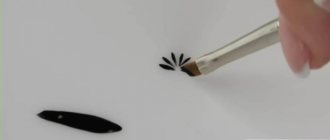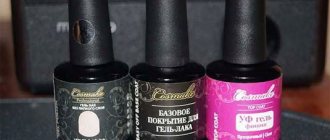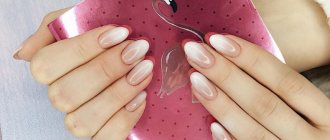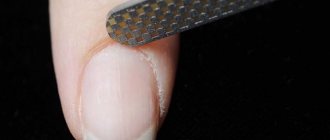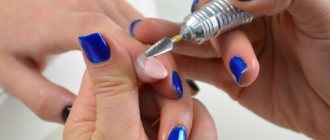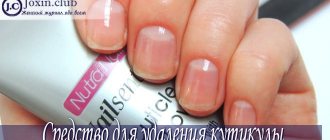Manicure brushes are the basis of a beautiful design. Moreover, even simple nail techniques will be difficult to perform if you do not take care of choosing a quality tool. The professional range of manicure paraphernalia offers a huge selection of accessories, so before purchasing nail brushes, you should understand which ones you need.
Type of brushes
A huge assortment of manicure tools is available in almost all cosmetic boutiques. They are sold individually or as a set.
Sets most often include all the necessary brushes designed to perform various tasks. Each brush has its own purpose.

A dotted or thin brush is used when fine details need to be applied. She draws patterns well. With such a thin manicure brush, you can also apply rhinestones or glitter quite easily.
A petal brush is needed for applying simple strokes and glitter. This tool has a flatter shape, unlike a point tool, and it also has a special corner.

You will need a fan brush for manicure when applying abstractions and landscapes. She can blend shades very well. It has a semicircle shape, which makes it quite easy to apply glitter.
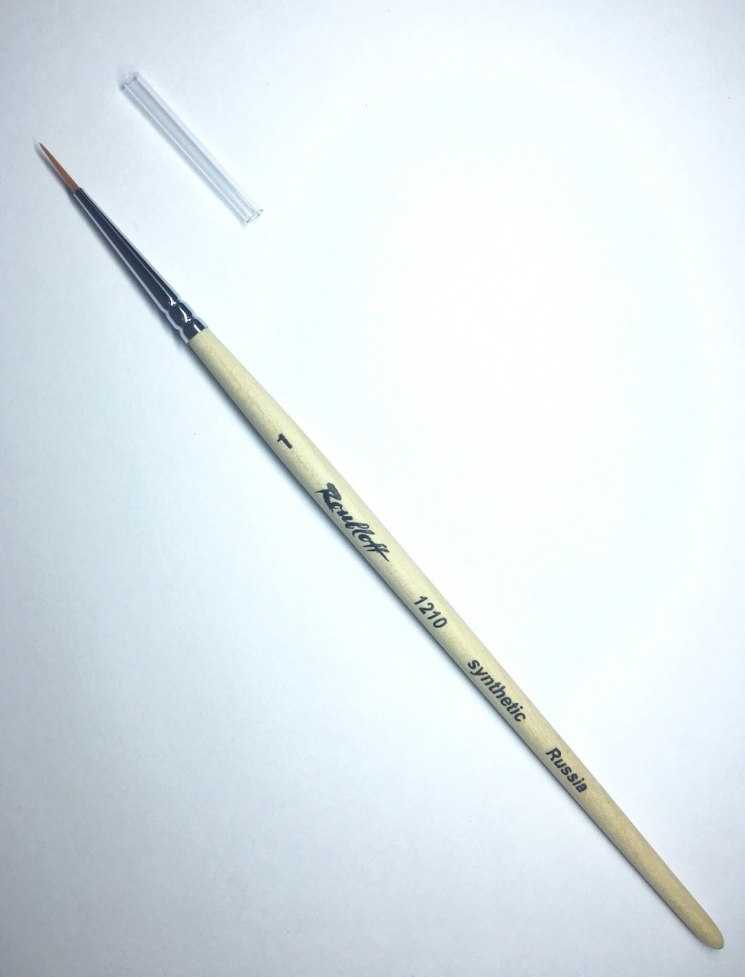
Using a dagger-shaped brush, complex three-dimensional drawings can be easily created. The tool has a flat, beveled end that allows you to pick up several polishes.
A wide brush is necessary when you want to completely cover the surface of the nail with varnish.
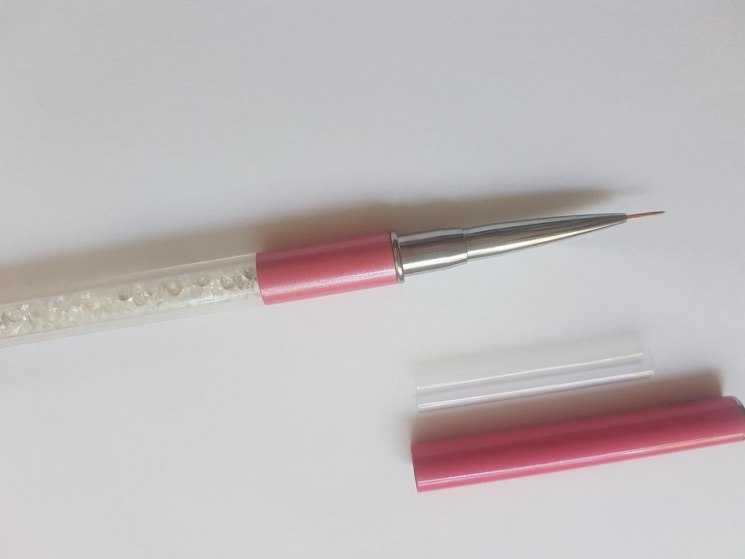
We recommend reading:

Cuticle removal - tips on choosing products and an overview of the best removal methods. 130 photos and videos of cuticle care- Beauty salon Persona-Mayakovskaya
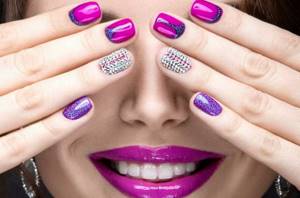
How to restore nails after gel polish - a review of the best means and methods of restoration at home (120 photos + video master class)
A tool that has a short pile at the end is most often used to draw curls of various shapes, as well as leaves.
The hair is available in piles of various lengths. With its help, more complex patterns are created: ornaments, animal drawings, straight lines.
You can easily notice the visual difference in the shapes and sizes of the bristles of each of the above tools in any photo of manicure brushes.

What materials are used to make brushes?
The brush consists of a handle, a metal tip and the beam itself. Depending on how the beam is assembled, what shape and length it has, determines the choice of instrument.
Material. Brushes come in synthetic brushes and natural brushes. Now synthetic materials give a head start to natural ones, as they benefit in the price/quality ratio. Nylon ones are very flexible, pliable, obedient, they use paint well and economically, and release it evenly - which ensures a uniform stroke. Easy to care for and very wear-resistant compared to natural fiber.
Natural brushes – these can be squirrel or kolinsky. The Lovely company uses natural kolinsky bristles. They are denser, but working with them is quite simple. If you work in Zhostovo or watercolor techniques, then you can use these brushes. They are denser, pick up paint well, and release it very softly and evenly. Very plastic.
For Chinese painting, it is also a good idea to use kolinok. Although synthetics are now of very high quality and are also suitable for these techniques.
Assembly
If the brushes are flat, then they are suitable for modeling and repairing nails. Perfect for applying base and color gel polishes. They are round and straight. The bunch of Lovely brushes is assembled in several layers, each layer is fixed and fixed well. These brushes do not fray. They keep their shape well and last a long time. If you take proper care of them, they will delight you for years to come.
A denser brush takes up more paint, while a sparse brush gives it away almost immediately. We change the shape and density of the stroke and print by pressing the tool and the amount of paint, depending on the desired pattern and design.
Shape and size
We can adjust the shape of the brush by how we place it. For example, the “Dagger” shape is a flat brush, it is quite long and has a beveled sharp long edge. Good for drawing large elements, for filling space and for finishing. Due to the beveled sharp tip, it can be used for monograms and for fine drawing.
Size is everyone’s personal preference, some people like to work with small brushes, others like large ones - everything is individual.
Length
The length and density of the stroke directly depends on the length of the brush. Pile length from 5 ml. They are quite maneuverable, flexible and obedient.
Purpose of brushes
There are 4 main groups into which manicure brushes are divided depending on the material to be worked with.
Brushes for gel and acrylic
Manicure brushes for acrylic and gel are designed more for modeling than for painting. With their help, craftsmen create French “smiles,” set dimensions, and work with sculpting and casting. This is why brushes for gel manicure and acrylic should be:
- different shapes - flat, square, cone-shaped;
- hard - for acrylic it is harder than for gel;
- comfortable - for high-quality work of the master.
Manicure brushes are very convenient. Thanks to this, they are slowly leaving the professional environment and are increasingly being used at home for everyday nail designs.
Acrylic brushes
Most often used for nail extensions. They are designed to help create the necessary bend and to model the shape.
We recommend reading:
- Magnet for a cat's eye: tips on how to apply iridescence simply and beautifully with your own hands (110 photos + video)
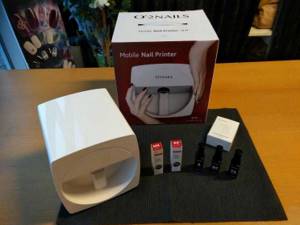
Manicure machine - tips on choosing the best models from professionals. Tips for choosing a device and manufacturer (95 photos)
- How to strengthen nails - a review of effective methods and means for strengthening long and short nails (145 photos + video description)
These brushes have a special bristle rigidity. It is very elastic and, when pressed, easily returns to its original form. The tip of this brush is very convenient for applying powder, creating a cuticle line.
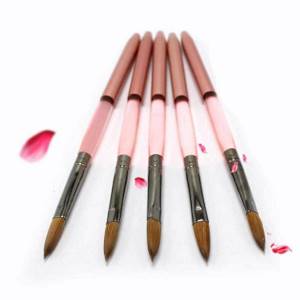
Using Brushes
Flat - for modeling, applying artificial coatings, base and color coatings. Ideal for applying gel polish or a base coat under the cuticle.
Thin or “dotted” and “Dagger” shape - for Zhostovo technique, watercolor, floristry.
Thin brushes for drawing, openwork, monograms.
For Chinese painting you need the end of the brush, so it must have elastic, dense bristles. It should not be long, because the brush for this painting works perpendicular to the surface, and so that it does not break. A pile length of 6-8 ml is sufficient. It can be a “Straight Square”, “Beveled Square” (larger or smaller). The smaller the detail in the design, the smaller the brush size. You can choose the middle one.
The “Petal” shape is ideal for sculpting. There are two types in the TM line - they differ in beam size and color. Both elastic and flat, very thin tips allow you to work out all the folds when working with 4D gel (plasticine). Very wear-resistant.
Brush for “French” manicure. Since there are different techniques for French coating, the master chooses brushes that are comfortable for himself, thin or dagger, for example. Hair brushes are ideal for creating fine lines and monograms.
The gradient brush is very popular for ombre and gradient manicure. 6 ml pile width, 11 ml pile length, nylon. The pile is perfectly evenly sparse, which allows you to create a beautiful smooth smoky transition in the gradient.
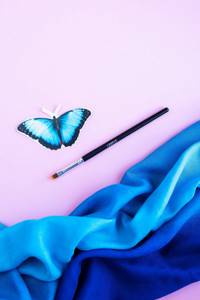
Brush care
After we have told you what and what a manicure brush is for, let's talk about care.
Proper care is important when using any tool. Manicure brushes are no exception. The service life of your brushes directly depends on how you properly care for them. It is under no circumstances recommended to use manicure tools for anything else. Nail design only. Otherwise, sudden hair loss will begin.
Do not keep the manicure brush under water for too long. This deforms the original appearance of its pile shape.
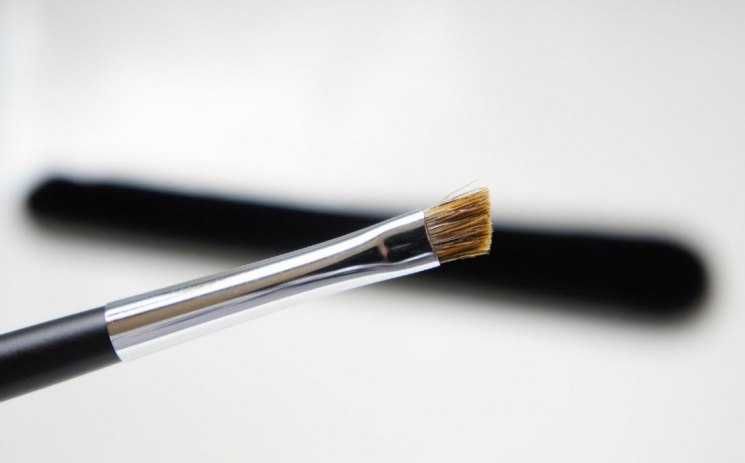
If this happens, we recommend holding the tool under hot water for several minutes. This will help restore the original look.
To avoid the varnish drying on the bristles, the brush should be washed immediately after use. If the varnish dries, you will need acetone to remove it, which has a detrimental effect on the fibers.
Do not expose brush bristles to hot air from a hair dryer.
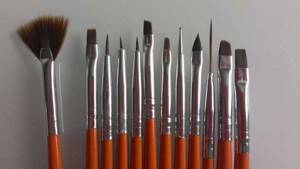
Before placing brushes in a special storage box, they must be thoroughly dried.
Number of brushes in the set and what types they are
Rather, it can be called a nominal classification. It helps you navigate among all the tools. Choose the one you need, gain an understanding of what kind of manicure brush it is and what it is intended for.
Sets that also include other additional tools (file, scissors, etc.) can be small. Two or three brushes can fit here. Or more with a number of brushes exceeding three varieties.
There will definitely be types with wide bristles, such as a fan manicure brush, and a variety with a zero number, that is, thin. The latter includes a dotting brush.
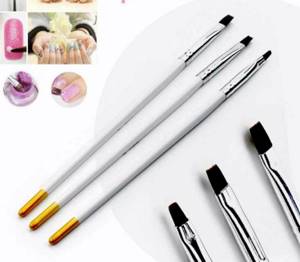
Creation at home
For those new to nail art, we can recommend creating a manicure brush from a regular paint brush.
To create, you will only need ordinary tweezers and a paint brush itself. Using forceps, carefully remove the tufts of villi at the base of the brush, moving from the edge to the center.
You need to make sure that the brush is located in the center. We carefully process the resulting pile with scissors to the size and length we need. As a result, we get a completely complete tool for manicure. Caring for this brush is very basic.
Purpose
1. Varnish brushes. They are beneficial to use if you are uncomfortable using a brush in a bottle of varnish, or if you want to make a pattern with your favorite varnish, but the thickness of the brush in the bottle does not allow this. They are also convenient to use for pedicures, as they are longer than the nail polish brush.
2. Brushes for acrylic modeling are used for nail extensions to create the shape of the nail and its bend. Brushes for acrylic modeling are distinguished by the fact that they have a round, sometimes flat working surface and a fairly hard, long bristle. It is convenient to apply powder with the tip to create a cuticle line and a smile, and with the middle part to distribute the material over the rest of the surface of the nail.
3. Brushes for gel modeling have the same purpose, but they use gel, which distinguishes them in their structure. They have a square or rectangular flat shape, sometimes even curved, and the pile is quite hard. This makes it easier to cope with the fluidity and viscosity of the gel.
4. Nail design brushes are used to draw various details when painting nails. They, in turn, can also be divided into categories:
- For drawing – used for drawing small design details. There are special brushes with short or, conversely, very thin and long bristles, curved brushes, their choice depends on your preferences and convenience.
- Modeling tools (they are also called sculptural ones) can be distinguished by their thin, sharp tip, which is used specifically for small and delicate sculpting details. With the help of such a brush you can create both small design elements and entire compositions.
- Fan brushes differ in appearance from others in that their bristles are made in the form of a fan, which is fastened to the handle. The purpose of these brushes is to work with artistic design elements such as mica, bouillons, glitter, as well as for shading colors and halftones.
- For Chinese painting. Chinese painting is one of the most interesting types of nail design, and for it they came up with a special series of brushes that can be purchased in a set. The peculiarity of these brushes is that some of them have an angled surface for ease of design.
Photos of manicure brushes
Please repost
0
1
How to match the Brush Strokes design to the length and shape of your nails
For those with short nails, the minimalist style in the “Brush Strokes” design is best suited. That is, the shorter the nails, the fewer strokes on the nails should be. Otherwise, you risk visually shortening the length of your nails even more.

Girls with long nails can safely combine the “Brush Strokes” design with French, lunar and abstract designs. You can additionally decorate your nails with foil or stickers, or add glitter.
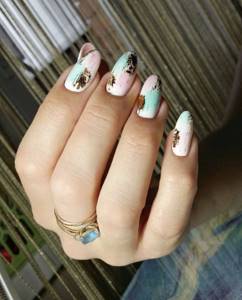
The “Brush Strokes” design is suitable for oval, square and almond nail shapes. This is a very versatile type of nail design.
Peculiarities
Manicure brushes differ from those analogues that are used for painting on paper or canvas. Their working part may consist of different materials; softness and elasticity will depend on this. The bristles can be natural or artificial; in addition, the shape of the brush may differ, which will determine the type of its use. With proper care, each such tool can serve the master for at least two years.
We don't think about the fact that all the brushes used by nail professionals have their own purpose. Some of them are used directly for design and creating a specific pattern. Options of natural origin, designed to work with acrylic nail products, can be made from sable, marten or sheep hair. Their shape can be very diverse.
Artificial and natural brushes
Artificial brushes are made from high-quality polymers and are much more affordable than natural ones. The disadvantage of such brushes is that their lifespan is quite short. If you are just starting to create designs on your nails, such brushes may well become your assistants in applying simple designs. Usually brushes are sold in sets of 3.5 and 12 pieces.
Natural brushes for nail art are made from kolinsky or sable wool. They cost more. The quality of such brushes is usually high and they can be used much longer than artificial ones. Using brushes made from natural materials, designs are made on nails using paints of any kind.
How to combine with different colors of gel polish and gel paint
The “Brush Strokes” manicure technique can be created with varnishes or gel paints of any color. But manicurists recommend combining three or four colors of varnish in a design. Moreover, one color should be bright or contrasting, and it is better to choose the remaining colors of varnishes or gel paints in the same color scheme.
You can apply strokes parallel to each other on all nails, or you can arrange them in a chaotic order. Here everything will depend on your mood or your wishes to the manicurist.
If you want something brighter, you can cover all your nails with red, white, black or neon polish and apply strokes of bright colors on top. For example, you can apply neon and crimson strokes to white nails. Or you can apply bright red and crimson strokes to neon nails. But, in the case of such contrasting combinations, it is better to use no more than two stroke colors.
The strokes look very gentle in combination with a nude manicure or with negative space. If you make the strokes brighter, then you can safely go to the party. And if you make them in pastel colors, then you can absolutely calmly go to the office or on a date.

Combining the Brush Strokes Design with Other Types of Nail Designs
Very interesting combinations can be obtained by combining a design using the “Brush Strokes” technique with some other types and design techniques. This way you can get an even more unique design on your nails. Let's look at some of them.
Combination with Abstract Design
Abstract nail design is no less spectacular and popular design technique. Often manicurists combine several techniques to get something new and exclusive and be one step ahead of the competition. You too can use this technique and get your own exclusive pattern on your nails.
For example, if you make the strokes more chaotic or smeared, and add different lines, dots, spots, pieces of foil to them, then the “Brush Strokes” design will become an Abstract design.

Minimalist brush strokes
If you prefer a light, laconic manicure without frills in design, then “Brush Strokes” in the “minimal” style is what you need. For example, you can apply a light base to all nails, and on one or two nails make a couple of neat, barely noticeable strokes.
An excellent choice would be a manicure in a milky shade with small, laconic pastel pink or light sky strokes. Nails in a natural beige shade with short pale mint strokes will also look great.
Strokes in combination with French
The strokes look unusual and stylish in combination with a French jacket. For example, you can use different colors of varnish to decorate the tips of your nails in a stylized French style. If these colors on the tips are light shades, it will seem as if you have wings, and you are all airy like a bird. A very gentle and romantic look is achieved with such a jacket.

Or you can use a jacket and strokes to create a more elegant look. For example, if you add vertical black strokes on several nails to any classic French jacket. The main thing here is not to overdo it with the number of strokes; it is better to make one vertical stroke on two or three nails. Otherwise, the image may turn out to be overloaded.
How to combine with decorations: foil, stickers, glitter and matte top
To make your look more festive and elegant, you can add a little sparkle in the form of glitter or pieces of foil to your strokes.

If you want sophistication, you can cover your nails with a matte topcoat. The strokes on the nails under the matte top look like toys.
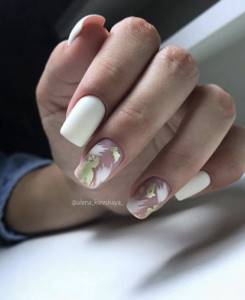
A manicure with strokes will also look beautiful and unusual if you place stickers with inscriptions or geometric shapes on top of the strokes themselves.



